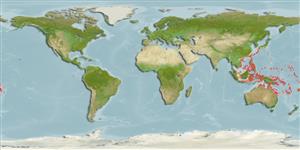Actinopterygii (ray-finned fishes) >
Perciformes (Perch-likes) >
Pomacentridae (Damselfishes) > Pomacentrinae
Etymology: Dischistodus: Greek, di = two + Greek, schistos = fissile stone, Plinius + Greek, odous = teeth (Ref. 45335).
Environment / Climate / Range
Ecology
Marine; reef-associated; non-migratory; depth range 1 - 12 m (Ref. 9710). Tropical, preferred ?; 35°N - 25°S
Western Pacific: southern Japan and the Ryukyu Islands, Taiwan, Philippines, Palau, Indonesia, Papua New Guinea, Solomon Islands, and the Great Barrier Reef. Reported from Vanuatu (Ref. 13300).
Size / Weight / Age
Maturity: Lm ? range ? - ? cm
Max length : 16.0 cm TL male/unsexed; (Ref. 9710)
Dorsal
spines
(total): 13;
Dorsal
soft rays
(total): 13-15;
Anal
spines: 2;
Anal
soft rays: 13 - 14. Adults have a large black patch on the abdomen reaching the anus; juveniles an ocellus over the center of the dorsal fin base (Ref. 48636). Body white, anterodorsal (or sometimes entire half of body) dark brown, opercle spots prominent pale large, belly patch dark brown. Body depth 2.0-2.1 in SL (Ref. 90102).
Adults occur in lagoon reefs and generally prefers small patch reefs with sand or rubble substrates (Ref. 1602). Feed on benthic algae which it aggressively guards against other herbivores (Ref. 9710). Juveniles secretive in rubble (Ref. 48636). Oviparous, distinct pairing during breeding (Ref. 205). Eggs are demersal and adhere to the substrate (Ref. 205). Males guard and aerate the eggs (Ref. 205).
Life cycle and mating behavior
Maturity | Reproduction | Spawning | Eggs | Fecundity | Larvae
Oviparous, distinct pairing during breeding (Ref. 205). Eggs are demersal and adhere to the substrate (Ref. 205). Males guard and aerate the eggs (Ref. 205).
Allen, G.R., 1991. Damselfishes of the world. Mergus Publishers, Melle, Germany. 271 p. (Ref. 7247)
IUCN Red List Status (Ref. 115185)
CITES (Ref. 94142)
Not Evaluated
Threat to humans
Harmless
Human uses
More information
ReferencesAquacultureAquaculture profileStrainsGeneticsAllele frequenciesHeritabilityDiseasesProcessingMass conversion
Tools
Special reports
Download XML
Internet sources
Estimates of some properties based on models
Phylogenetic diversity index (Ref.
82805): PD
50 = 0.5078 [Uniqueness, from 0.5 = low to 2.0 = high].
Bayesian length-weight: a=0.02570 (0.01300 - 0.05081), b=3.00 (2.84 - 3.16), in cm Total Length, based on LWR estimates for this species & (Sub)family-body (Ref.
93245).
Trophic Level (Ref.
69278): 2.0 ±0.00 se; Based on food items.
Resilience (Ref.
69278): High, minimum population doubling time less than 15 months (Preliminary K or Fecundity.).
Vulnerability (Ref.
59153): Low to moderate vulnerability (27 of 100) .
